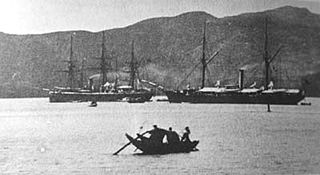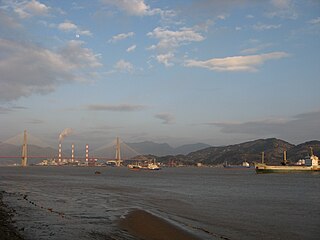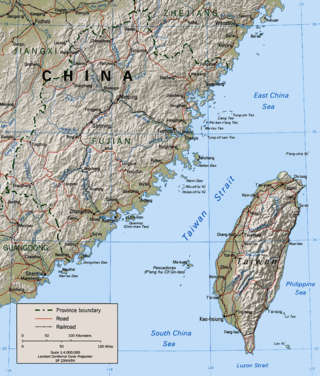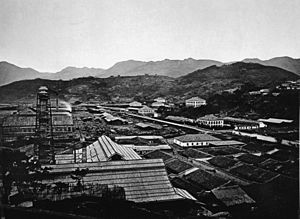
Fuzhou, alternately romanized as Foochow, is the capital and one of the largest cities in Fujian province, China. Fuzhou lies between the Min River estuary to the south and the city of Ningde to the north. Together, Fuzhou and Ningde make up the Mindong linguistic and cultural region.

The Battle of Fuzhou, or Battle of Foochow, also known as the Battle of the Pagoda Anchorage, was the opening engagement of the 16-month Sino-French War. The battle was fought on 23 August 1884 off the Pagoda Anchorage in Mawei (馬尾) harbour, 15 kilometres (9.3 mi) to the southeast of the city of Fuzhou (Foochow). During the battle Admiral Amédée Courbet's Far East Squadron virtually destroyed the Fujian Fleet, one of China's four regional fleets.
The Self-Strengthening Movement, also known as the Westernization or Western Affairs Movement, was a period of radical institutional reforms initiated in China during the late Qing dynasty following the military disasters of the Opium Wars.

Fuqing (help·info) (Chinese: 福清; pinyin: Fúqīng; Wade–Giles: Fu2-ch'ing1; Pe̍h-ōe-jī: Hok-chhiaⁿ; Foochow Romanized: Hók-chiăng; also romanized as Hokchia) is a county-level city of Fujian Province, China, it is under the administration of the prefecture-level city of Fuzhou.

François Léonce Verny, was a French officer and naval engineer who directed the construction of the Yokosuka Naval Arsenal in Japan, as well as many related modern infrastructure projects from 1865 to 1876, thus helping jump-start Japan's modernization.

The Canton System served as a means for Qing China to control trade with the West within its own country by focusing all trade on the southern port of Canton. The protectionist policy arose in 1757 as a response to a perceived political and commercial threat from abroad on the part of successive Chinese emperors.

The Beiyang Fleet was one of the four modernized Chinese navies in the late Qing dynasty. Among the four, the Beiyang Fleet was particularly sponsored by Li Hongzhang, one of the most trusted vassals of Empress Dowager Cixi and the principal patron of the "self-strengthening movement" in northern China in his capacity as the Viceroy of Zhili and the Minister of Beiyang Commerce (北洋通商大臣). Due to Li's influence in the imperial court, the Beiyang Fleet garnered much greater resources than the other Chinese fleets and soon became the dominant navy in Asia before the onset of the 1894–1895 First Sino-Japanese War. It was the largest fleet in Asia and the 8th in the world during the late 1880s in terms of tonnage.

Shen Baozhen (1820–1879), formerly romanized Shen Pao-chen, was an official during the Qing dynasty.

Heien, originally known as Pingyuan, was an ironclad coastal battleship that served with the Imperial Chinese Beiyang Fleet and later the Imperial Japanese Navy. It was built by the Mawei Navy Yard near Fuzhou. Previous transliterations of its Chinese name include Ping Yuen and Ping Yuan, and an alternative transliteration of its Japanese name was Heiyen.

The Imperial Chinese Navy was the modern navy of the Qing dynasty of China established in 1875. An Imperial naval force in China first came into existence from 1132 during the Song dynasty and existed in some form until the end of the Qing dynasty in 1912. However, the "Imperial Chinese Navy" usually only refers to the Qing navy, which existed between 1875 and 1912.

Fuzhou people, also known as, Foochowese, Hokchew, Hokchia, Hokchiu, Fuzhou Shiyi people (福州十邑人), Eastern Min or Mindong refer to Chinese who originate from the Fuzhou and Mindong regions and the Gutian and Pingnan counties of Fujian province and Matsu Islands in Taiwan. Fuzhou people are a part of the Min Chinese-speaking group that speaks Eastern Min or specifically Fuzhou dialect. There is also a significant overseas Fuzhou population, particularly distributed in Malaysia, Indonesia, Japan, United States, Singapore and the United Kingdom.

The Fujian Fleet founded in 1678 as the Fujian Marine Fleet was one of China's four regional fleets during the closing decades of the nineteenth century. The fleet was almost annihilated on 23 August 1884 by Admiral Amédée Courbet's Far East Squadron at the Battle of Fuzhou, the opening engagement of the Sino-French War.

Yangwu was a wooden corvette built for the Imperial Chinese Navy. She was built in 1872 at the Foochow Arsenal, and was the largest ship built there from the shipbuilding programme of 1868–75. During her early career, she was used as a training ship and under the command of English captains. She later saw action in the Battle of Fuzhou in 1884, the opening action of the Sino-French War, where she acted as the flagship of the Fujian Fleet. Shortly after the start of the battle, she was damaged by a spar torpedo, causing a large explosion and the loss of the majority of her crew; she was sunk shortly afterwards by enemy fire.

Mawei is one of 6 urban districts of the prefecture-level city of Fuzhou, the capital of Fujian Province, China. The district spans an area of 319.66 square kilometers, of which, 275.66 square kilometers is land. The district had a population of 231,929 as of 2010.

The Nagasaki incident, also known as the Nagasaki―Qing Navy Incident (長崎清国水兵事件) was an incident took place on August 13, 1886 during the Beiyang Fleet visit to Nagasaki, Japan. Some Chinese sailors violated military discipline when they went ashore for shopping, went to local brothels and drank and made troubles. As a result, they clashed with the Japanese police. A Japanese policeman was stabbed and seriously injured, and a Chinese sailor was slightly injured. In February 1887, the two sides reached an agreement under the mediation of the British and German ministers. Both parties compensated the dead and injured persons of the other party.
Late Qing reforms, commonly known as New Policies of the late Qing dynasty, or New Deal of the late Qing dynasty, simply referred to as New Policies, were a series of cultural, economic, educational, military, diplomatic, and political reforms implemented in the last decade of the Qing dynasty to keep the dynasty in power after the invasions of the great powers of the Eight Nation Alliance in league with the ten provinces of the Southeast Mutual Protection in the Boxer Uprising.

Jinshan Temple is a Buddhist temple located on an island of Wulongjiang River, in Cangshan District of Fuzhou, Fujian, China. It is the only Buddhist temple in the river in China and the only Buddhist temple on the water in Fujian.

The Fujian–Taiwan relations, also known as the Min–Tai relations, refers to the relationship between Fujian, which is located in mainland China, and Taiwan, which is across the Taiwan Strait. Since the average width of the Taiwan Strait is 180 kilometers, Fujian and Taiwan are adjacent, similar in both climate and environment. Although the relationship between Taiwan and Fujian has changed with the development of history, the two places have maintained close relations in terms of personnel, economy, military, culture and other aspects. At present, Taiwan residents are mostly descendants of immigrants from mainland China, of which the southern Fujian ethnic group is the main group, accounting for 73.5% of Taiwan's total population. In terms of culture, language, religion, and customs, Fujian and Taiwan also share similarities.















